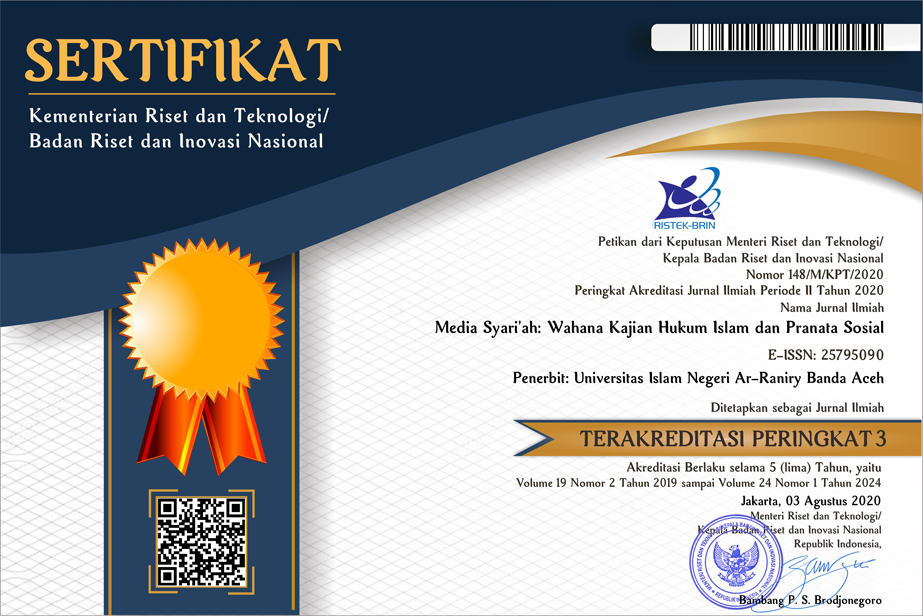Film Sebagai Pemankin Pembangunan Peradaban Melayu-Islam Modern
DOI:
https://doi.org/10.22373/jms.v14i1.1723Keywords:
Film, Development, Islamic-Malay CivilizationAbstract
This article discusses on the genre of Islamic film as a visual creative innovation that had played a significant role in the society. Film can be regarded as a effective platform in distributing an Islamic idealism propose by the Malaysian and Indonesian’s film director. Obviously the inclusion of Islamic point of view for the development of Malay-Muslim civilization can be done through the medium of film. Based on such background setting, the article had touched on several issues pertaining to the issues of contemporary Islamic problem and collective role needed to be played by both of Islamic scholar and film director. It is suggested that a mutual understanding between ulamak and film director will contributed toward the betterment of Islamic ummah at the modern time.References
Abdullah, A. R. (1997). Pemikiran Islam di Malaysia: Sejarah dan Aliran. Jakarta
Abdullah, A. K. (1988). Unsur-unsur Islam dalam Puisi Melayu Modern. Kuala Lumpur
Abdullah, M. A. (2006). Islamic Studies di Perguruan Tinggi: Pendekatan Integrative- I n t e r k o n e k t i f . Yogyakarta: Pustaka Pelajar
Ahmad, H. (2006). Memperkasa Bangsa Melalui Kekuatan Dalaman: Ke Arah Kelahiran Melayu Glokal. Kuala Lumpur: Alaf 21 Sdn Bhd
______.(2003). Metafora Melayu: Bagaimana Pemikir Melayu Mencipta Makna dan M e m b e n t u k Epistemologinya. Sungai Ramal Dalam: Akademi Kajian Ketamadunan
Al-Attas, S. H. (2005). “Watak Tertawan di Negara Membangun“, dalam Mohamad Daud
Mohamad (ed. oleh), Pascakolonialisme dalam Pemikiran Melayu. Kuala Lumpur: DBP Al-Edrus, S. M. D. (1999). Epistemologi Islam: Teori Ilmu dalam Al-Quran. Kuala Lumpur
An-Najar, A. M. (2002). Kebebasan Berfikir dalam Islam. Jakarta: Pustaka Firdaus.
Bakar, I. A. (1994). Islamic Modernism in Malaya. Kuala Lumpur: Penerbit Universiti Malaya.
Bakar, S. A. (1995). “Takmilah: Teori Sastera Islamâ€. dalam Nadwah Ketakwaan Melalui Kreativiti. Kuala Lumpur: DBP
_______.(1987). “Ruba’i: Pengaruhnya di dalam kesusasteraan Melayuâ€, dalam Cendekia Kesusasteraan Melayu Tradisional. Kuala Lumpur
Daud, W. M. N. W. (1990). “Budaya Ilmu sebagai Asas Pembangunan Tamaddunâ€, dalam Jurnal Pendidikan Islam. v. 3, bil. 1
Darusalam, G. (1998). Dakwah Islam dan Ideologi Barat. Kuala Lumpur
Fadl, M. M. A. (1995). Toward Global Cultural Renewal: Modernity and The Episteme Of Transcendece. Herndon
Faghizadeh, S. (2004). Sosiologi Sosiologi. Terjemahan Oleh Mohd Fauzi Yaacob. Kuala Lumpur: ITNMB
Gerges, F. A. (1999). America and Political Islam; Clash of Cultures or Clash of Interest.Cambridge: Cambridge University Press
Hamidon, N. A. (2000). “Sikap Islam terhadap Isu Seni Figuratif “, dalam Jurnal Usuluddin. bil. 12
Hamzah, A. B . (1981). Al-Imam: Its Role in Malay Society 1906-1908. Kuala Lumpur
Hasan, M. K. (2001). dalam Intellectual Discourse At the End of The Second Millennium: Concerns of A Muslim-Malay CEO. Kuala Lumpur: UIAM
Hassan, M. K. (1996). “Islamic Intellectual Patterns in the Malay-Indonesian Archipelago: A Historical Surveyâ€. dalam Toward Actualizing Islamic Ethical And Educational Principles In Malaysian Society. Petaling Jaya
Heath, P. (1996). “Some American Perceptions of Developing Muslim Countries“, (edit) Aidit Haji Ghazali. Development, Islamic, Malaysian And American Perspectives. Kuala L u m p u r : INMIND
Huntington, S. (1993). “ The Clash of Civilizations?. dalam Foreign Affairs. Summer 1993
Husain, A. (1984). “The Ideology of Orientalism“. dalam Orientalism, Islam and Islamist. Vermont
Husaini, S. W. A. (1980). Islamic Environmental System Engineering. London
Hussein, S. A. (2002). “Muslim Politics and Discourse on Democracy “, dalam Democracy in Malaysia; Discourse and Practices. Richmond, Surrey: Curzon Press
Ishak, M. S. A. (2000). The Malays In The Middle East, With a Bibliography of Malay Printed Works Published In The Midde East. Kuala Lumpur
Jaafar, Z. (1998). “al-Quran dan Globalisasiâ€. dalam Monograf Minda KISDAR. Shah Alam: KISDAR
Jailani, R. (2003). “Hubungan Pendidikan Seni dengan Konsep Tauhid “, dalam (edit) oleh Mohd. Radzi Othman, Warisan Al-Quran: Aspek Sosiobudaya. Pulau Pinang: Penerbit USM
Kailani, M. I. (2000). Kebangkitan Generasi Salahuddin dan Kembalinya Jerusalem ke P a n g k u a n Islam, terj. Abdullah Abbas. Kuala Lumpur: Thinker Libraries
______.(1999). Mendidik Peribadi Muslim. Kuala Lumpur: Berita Publishing.
Lewis, B. (1993). “Islam and Liberal Democracy“, dalam Atlantic Monthly. Februari 1993
______.(1990). “The Roots of Muslim rage“, dalam Atlantic Monthly. September 1990
Majid, M. K. A. (2001). “Pertembungan Tamaddun Islam dengan Kolonialisme Baratâ€. Dalam Tamaddun Islam dan Tamaddun Asia, Kuala Lumpur: DBP
Musa, H. (2001). Merekonstruksi Tamadun Melayu Islam: Ke Arah Pembinaan Sebuah Tamadun Dunia Alaf Baru. Kuala Lumpur
Naim, A. S. M. (2003). Konsep, Teori, Dimensi dan Isu Pembangunan, Skudai: Penerbit UTM
Newby, G. D. (1996). “Muslim/Non-Muslim Relations: Lesson From The Past For a Better
Futureâ€, dalam (edit) Aidit Haji Ghazali, Development, Islamic, Malaysian And A m e r i c a n Perspectives. Kuala Lumpur: INMIND
Nieuwenhuijze, C.A.O V. (1969). “Legacy of Islam in Indonesiaâ€, dalam The Muslim Wo r l d . v. L1X
Nor, M. A. M. (1990). The Zapin Melayu Dance of Johor: From Village to a National P e r f o r m a n c e Tradition. University of Michigan
Osman, M. (2004). Kemahiran Berfikir. Kuala Lumpur: INTAN
Osman, M. T. (1989). Malay Folk Beliefs: an Integration of Disparate Elements. Kuala Lumpur
______.(1980). “Islamisation of the Malays: a Transformation of Cultureâ€, dalam Tamadun Islam di Malaysia. Kuala Lumpur
Othman, A. H. (1993). Psikologi Melayu. Kuala Lumpur
Qardawi, Y. (1992). Wawasan Islam Antara Keaslian aan Kemodernan, terj. Ahmad Nuryadi Asmawi. Kuala Lumpur
Rahim, R. A. A. (2009). “Paradigma Wasatiyyah dan Dailog Peradaban: Satu Analisisâ€, Jurnal Peradaban. Pusat Dailog Peradaban. UM. v. 2
______.(2008). â€Perubahan Sosial dan Impaknya terhadap Pembentukan Modal I n s a n
Menurut Ibn Khaldunâ€, dalam Jurnal Hadhari. Institut Islam Hadhari UKM. v. 1
_______.(2006). “Islam dan Isu Penterjemahan dalam Era Globalisasi “, dalam (edit) Hamedi Mohd Adnan. Penerbitan Malaysia-Indonesia: Mengukuhkan Jaringan Penerbitan Serantau. Kuala Lumpur : Penerbit UM
______.(2006). “Ulamak Dan Paradigma Menanggani Kebudayaan Melayuâ€, dalam (edit) Othman Yatim. Wacana Budaya. Kuala Lumpur: APMUM
______.(2003). “Al-Quran dan Peranan Ulamak Melayu dalam Pemodernan Rantau
Alam Melayu“, dalam Mohd Radzi Othman (ed. oleh) Warisan al-Quran dan P e r a d a b a n Manusia Siri 1. Pulau Pinang: Penerbit Universiti Sains Malaysia
(2003). “Analisis Sejarah Dakwah dan Jalinan Intelektual Rantau Malaysia- Indonesia“. dalam (edit oleh Zulkiple Abd. Ghani). Jaringan Dakwah Malaysia- I n d o n e s i a . Bangi: UKM dan Universitas Muhammadiyah Sumatera Utara (UMSU)
______.(1999). “Krisis Remaja dan Media Massa di Malaysia: Suatu Tinjauan dari Perspektif Islam“. dalam Jurnal Usuluddin. bil. 10
Safi, L. M.(1998). Truth and Reform: Exploring the Patterns and Dynamics of Historical Change. Kuala Lumpur: Open Press Publication
Sani, M. A. M. (2002). Hak Asasi Manusia Menurut Pandangan Islam dan Barat. Kuala Lumpur: Penerbitan PTS
Sikana, M. (1996). Falsafah dan Seni Kreatif Melayu. Kuala Lumpur
Soleh, A. K. (2004). Wacana Baru Filsafat Islam. Yogyakarta: Pustaka Pelajar
Stapa, Z. (1999). “Ancaman Pasca Modern dan Faham Modernisme terhadap Akidah dan Akhlak Umat Islam Masa Kiniâ€. dalam al-Maw’izah, v. 7
_______.(1997). “Negara Malaysia yang Maju dan Berakhlak Mulia: Realitas dan Kemungkinanâ€. dalam Jurnal IKIM, V. 5, NO. 1
Sulaiman, M. J. (1999). “Peluang Ummah dalam Pembangunan Multimediaâ€. Dalam Multimedia dan Islam. Kuala Lumpur
Sulaiman, S. TM. (2001). “Budaya Hiper dan Ekstasi Gaya Hidup Remaja dalam Era Siberâ€. dalam Jurnal YADIM, bil. 2
Wahab, S. A. (2001). “Madonna, Pascamodern dan Kebudayaan Popularâ€, dalam Jurnal YADIM, bil. 2
Downloads
Published
Issue
Section
License
MEDIA SYARI'AH: Wahana Kajian Hukum Islam dan Pranata Sosial has CC-BY-SA or an equivalent license as the optimal license for the publication, distribution, use, and reuse of scholarly work. Authors who publish with this journal agree to the following terms:
1. Authors retain copyright and grant the journal right of first publication with the work simultaneously licensed under a Creative Commons Attribution-ShareAlike 4.0 International License that allows others to share the work with an acknowledgment of the work's authorship and initial publication in this journal.
2. Authors are able to enter into separate, additional contractual arrangements for the non-exclusive distribution of the journal's published version of the work (e.g., post it to an institutional repository or publish it in a book), with an acknowledgment of its initial publication in this journal.
3. Authors are permitted and encouraged to post their work online (e.g., in institutional repositories or on their website) prior to and during the submission process, as it can lead to productive exchanges, as well as earlier and greater citation of published work (See The Effect of Open Access).
You are free to:
Share — copy and redistribute the material in any medium or format.
Adapt — remix, transform, and build upon the material for any purpose, even commercially.
The licensor cannot revoke these freedoms as long as you follow the license terms.
All papers published in MEDIA SYARI'AH: Wahana Kajian Hukum Islam dan Pranata Sosial are licensed under a Creative Commons Attribution-ShareAlike 4.0 International License.



.png)


.png)
.png)
.png)



